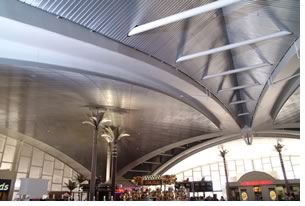

03/2005
AIA convention-goers will have an easier time going through Las Vegas’ McCarran International Airport now that expansion and new technologies have eased terminal congestion and made flying in and out a smoother experience.
In fewer than 15 years, passenger traffic has doubled at McCarran, located just a few miles from the Las Vegas strip and downtown. The volume of travelers reached 41.44 million last year, 14 percent more than 2003, making it the seventh busiest airport in the U.S. To deal with the increase, the airport has undergone a tremendous amount of construction expansion in the last 20 years. Also, it has implemented myriad technological upgrades just in the last few years. Both the construction and technology projects were divided into five phases at a cost of $1.8 billion, and are all expected to be complete this year. The most recent expansion finished last April when McCarran added 10 gates.
When all the projects are done, McCarran will have added a total of 40 gates, two new concourses, two runway expansions and a new parallel runway, new landside roadways and freeways, tunnels and bridges, an automated “people-mover” transit system, and radio-frequency identification “RFID” luggage tags that move and track bags by radio frequency instead of bar codes through security and onto flights faster and more efficiently.
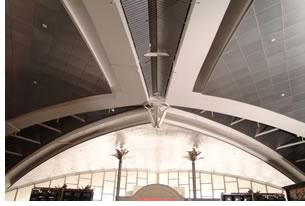 McCarran pioneers in many ways
McCarran pioneers in many ways
McCarran is the first to use the RFID system on a large scale. The interesting
aspect about the tag system has a lot to do with McCarran itself. The
airport controls the facility’s entire information technology
system, unlike other airports in which each airline manages its own
technology on-site. McCarran’s Common Use Terminal Equipment,
the first of its kind in any airport, controls all technology at all
check-ins and gate desks, which in turn connect to each airline’s
departure control system.
This “common use” technology allows for a universal baggage-handling system throughout the airport. Radio tags don’t work well without an airport-wide system; there would be too much confusion. As it is, all bags at McCarran are tracked in one fast system from drop-off to transfer to pickup, which also reduces the chance of lost or mishandled bags.
The radio-tag chips, operating at 900 megahertz, store information about each bag more accurately than barcodes can. For instance, barcode strips sometimes fail at the scanner if a strip is placed even a fraction of an inch off its mark.
McCarran was also first to implement TIPS, the Traveler Information Prescreening Series of 11 video vignettes shown throughout the airport. The videos feature many Las Vegas luminaries explaining how to navigate a range of security checkpoint issues, such as how to prepare a baby’s stroller for inspection. “With this level of growth, you need an out-of-the-box concept that’s proactive and efficient,” said Randall H. Walker, Clark County Department of Aviation director. “Every airport in the country is experiencing longer wait times in security. The difference now is that McCarran passengers will enjoy watching the TIPS programming and therefore be better prepared upon entering the checkpoint.”
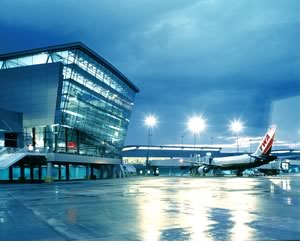 Further additions
Further additions
The security capacity was expanded last August from 12 to 19 lanes to
better handle passenger screening. “Customer service was a prime
motivation in our acceleration of the construction schedule,” said
Walker. To increase the checkpoint area, the mezzanine in front of
the checkpoint was expanded to approximately 19,000 square feet and
now covers approximately one-third of the south baggage claim area.
The checkpoint includes two lanes that are dedicated “selectee” lanes
for processing passengers requiring additional security screening.
Travelers with wireless laptops or personal digital assistants can now access Internet and e-mail anywhere in McCarran, due to its new free WiFi high-speed wireless access system, the largest of any airport in the country. McCarran is able to provide the free service because it owns and operates its own airport-wide telecommunications infrastructure.
Some hotels give travelers the opportunity to check in while at the airport. Leaving Las Vegas is made easier if a traveler needs a new boarding pass with SpeedCheck kiosks located at the airport. The kiosks can print a new boarding pass on the spot, foregoing lines at a ticket counter. (Boarding passes can also be acquired at skycap curbside stations.) Travelers can’t get one at the gate anymore, because they have to have it with ID to get through the security checkpoint. Coming soon for McCarran is remote check-in, by which travelers going home can print boarding passes and check in luggage from their Vegas hotel. A subcontractor would tag the bags on-site and ship them to McCarran.
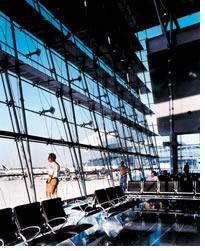 Right now, McCarran is composed of two terminals. A third terminal in
the works is slated to open in 2009. The Gate D concourse of terminal
1 is noteworthy because its glass configuration reflects an aeronautical
theme, with one wing to the southeast and one to the southwest of the
main rotunda, all under a sweeping curved roof, evoking an image of flight.
Right now, McCarran is composed of two terminals. A third terminal in
the works is slated to open in 2009. The Gate D concourse of terminal
1 is noteworthy because its glass configuration reflects an aeronautical
theme, with one wing to the southeast and one to the southwest of the
main rotunda, all under a sweeping curved roof, evoking an image of flight.
McCarran is also home to lots of slots. Travelers can get off the plane and try their luck at the jackpot immediately. The slots can also serve as their last chance to hit it big as they get ready to board for home.
Both Vegas and McCarran International show no signs of slowing down. As Walker points out, “We expect our passenger count to continue increasing well into 2005.”
What you need to know
Below are a few tips to help you on your trip to Vegas.
Airport security
- Tag carry-on luggage with your personnel information. Bring valid
ID.
- Pack footwear on top of other contents in your luggage. But don't
stack piles of books or documents on top of each other; spread them out.
- No matches or lighters of any kind are permitted in checked baggage.
- Avoid wearing shoes, clothing, jewelry, and accessories that contain
metal.
- Carry-on baggage is limited to one carry-on bag plus one personal
item. Personal items include laptops, purses, small backpacks, briefcases,
or camera cases.
- Place the following items in your carry-on baggage prior to entering
the screening checkpoint: cellular phones, large amounts of jewelry,
keys, loose change, money clips, lighters, large belt buckles, and metal hair
decorations.
- Be prepared to turn
on all electronic devices including computers, cellular phones, beepers,
etc., as requested. Be prepared to take your laptop out of the case.
Tape your business card to the bottom of your laptop to avoid loss
or the accidental “exchange” by
travelers.
- Take off your outer coat, suit coat, jacket, or blazer at the screening
checkpoint.
- Certain items are prohibited in your luggage. Visit the TSA Web site for the complete list.
Getting around in Vegas
Taxicabs are available outside the east side of the baggage claim,
outside door exits 1-5. Taxis will not accept credit card payments.
From McCarran Airport the approximate taxi fares are:
- South Strip (Where
Mandalay Bay is located)—$8.50-$11
- Center Strip—$10-$13
- Downtown Area—$17-$20.
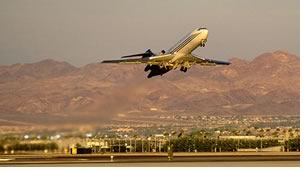 A variety of shuttle and limousine services also is available at McCarran,
and pickup is located on the north and west sides of the baggage claim,
outside door exits 8-14. The average cost of a shuttle ride to the strip
is $8 and about $10 to downtown hotels. Rental car counters are located
in the center of the baggage claim area. Every rental agency provides
its own airport courtesy shuttle to transport customers to lots.
A variety of shuttle and limousine services also is available at McCarran,
and pickup is located on the north and west sides of the baggage claim,
outside door exits 8-14. The average cost of a shuttle ride to the strip
is $8 and about $10 to downtown hotels. Rental car counters are located
in the center of the baggage claim area. Every rental agency provides
its own airport courtesy shuttle to transport customers to lots.
Las Vegas’ new monorail provides a cooler alternative to walking in the desert heat. The sleek, high-tech, $650 million transit system travels along the strip and links eight major hotels. A one-way trip is $3, with round-trip fare $5.50. The monorail runs from 8 am till midnight.
Leaving Las Vegas
Passengers flying during peak travel periods should arrive at least two
hours prior to their flight to allow adequate time to check in and
process through the security checkpoint.
Copyright 2005 The American Institute of Architects.
All rights reserved. Home Page ![]()
![]()
 |
||
| For more Las Vegas travel information: Visit the McCarran International Airport Web site. Visit the Mandalay Bay Resort & Casino Web site. Visit the official City of Las Vegas Web site. Photos 1, 2, from the AIA Nevada Web site: Terminal D architect: Tate Snyder Kimsey Did you know . . . ? On the site of McCarran once was Alamo Airport, established in 1942 by aviator George Crockett, a descendant of frontiersman and Alamo combatant Davy Crockett.
|
||
